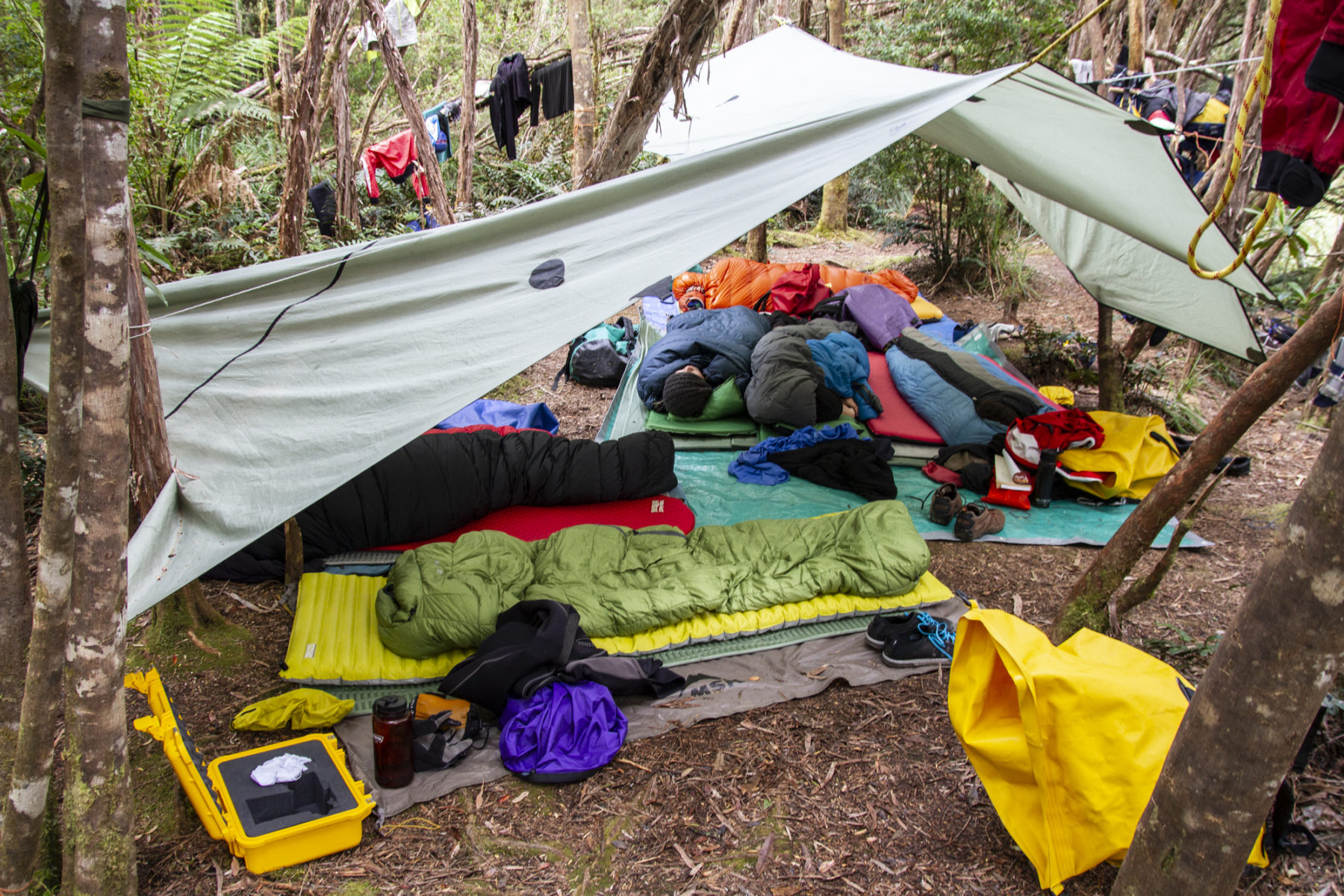Victor warned me, very loudly, but it was too late. “Get down!” was his shout, but I was a split-second too slow. It had taken the waters of the Franklin River millions of years to carve away some of that huge rock, so I – or, more accurately, my back – had no hope of budging the thing. So, I hit it, at considerable speed, and as I lay face-first in the raft struggling to breathe, I could only thank my portable floatation device (PFD) for me not copping anything worse than a huge winding. It was a not so subtle demonstration of the power of the Franklin River.
A dream begins
I spent my childhood mucking around in canoes on the slow-moving rivers and creeks of south coast NSW. The whitewater of Australia’s big rivers seemed a world away and it took a child’s vivid imagination to compensate for the placid character of our local waterways.
I first discovered the Franklin River in the early ’80s. Like many others, my knowledge came courtesy of the numerous news stories centred around the potential damming of one of Australia’s last wild rivers. I was in high school but can still recall the television footage showing the flotilla of protestors’ rafts, kayaks and canoes, cluttering up the Franklin’s lower sections. My interest was also piqued by Peter Dombrovskis’ famous photo of Island Bend and old reel film of the Franklin’s epic rapids.
Eventually, passion and enthusiasm (with a bit of help from a political party and the High Court) triumphed over energy and money. The Franklin River would not be dammed. More importantly – for my 13-year-old self, at least – a paddling dream stayed alive.
The wild side of the Franklin River
More than thirty years is a long time to wait. But, as the next nine days were about to prove, the rewards for great patience can be immense. Satisfaction was the governing emotion as I helped pack a pair of bright yellow World Expeditions rafts, moored on the rocky banks of the Collingwood River, in advance of setting off on a guided journey with World Expeditions, to fulfil that dream. Guides Oscar, Victor and Dan were directing our group of seven paddlers (Rob and Saffron, Peter, Dave and Gina, Phil and myself) as we loaded the two rafts and divvied ourselves into two rafting crews. We’d have a guide in each raft, plus a third guide would act as a forward scout in a kayak. This guided journey down the Franklin is
The weather was perfect, and the river was calling. Or the Collingwood River, at least – we had about an hour or so of paddling this waterway before we reached the confluence with the Franklin. The introduction was gentle, with the river at an average flow-height – perfect for paddle-stroke and rafting tuition.

We soon mastered the commands of “back paddle”, “forward” and most importantly, “get down”. What we hadn’t mastered was the negotiation of some of the trickier, shallow rapids we encountered very early on. These required much pushing and shoving from Oscar, our guide (I was in a raft with Rob, Saffron and Dave), along with the crew shifting our weight from side to side, as we tried to shift the raft off the rocks – not an easy task considering its size and weight.
These incredibly bright, yellow watercraft were the marine equivalent of a Land Rover 4WD – able to take a surprisingly heavy load of crew and equipment (esky, food boxes, sleeping gear, cooking gear, etc., all secured with tie-downs). Victor estimated each raft weighed, all up, about 700kg. It wasn’t hard to believe. With five adults on board, plus all the equipment, it was amazing that these things could move at all. But they did and when surfing down some of the faster rapids – Sticks and Stones was a standout – the rafts reached impressive speeds. This meant paddle strokes, and paddlers’ positions, had to be adjusted very quickly for a successful run.
More than just paddling
One of the Franklin River’s many attractions is its camp sites and, even on the first day, I was seriously impressed. Angel Rain Cavern was our aptly named first camp site – we slept on air mats, perched in a cliff under a large overhang, while the river flowed below.
We left Angel Rain Cavern early the next morning, but 10 minutes later we were back on land at our first big portage. The Log Jam was a series of massive logs shoved up against a series of huge boulders, with no way through. The guides tackled this portage; us punters sat perched on a slippery rock face. Water teemed over us from an overhang and rushed through a series of man-sized gaps between the logs below us.
Once the guides had dragged and dropped each raft over the huge logs, we had to tightrope walk along a log then lower ourselves (mainly falling ungainly) into our raft. At that point, it looked like we’d have a fairly easy time, watching the guides portage any difficult sections, while we kept out of the way. A foolish assumption, as it turned out.

After a series of shallow rapids, some flat water, and pauses to admire big, beautiful Huon pine trees, we reached Nasty Notch and the grunt work started. Manhandling the rafts over a series of rock ledges, even when emptied of rafters, was no easy task. The rocks underfoot were slippery (although you’d never know it, watching the guides dance lightly over them) and the rotund sides of a raft don’t make the best handholds, but it is amazing how fear aids concentration. The portage was hard but fun. We managed to get the rafts – and ourselves – to the other side, incident-free, and felt a satisfying sense of achievement.
From here we paddled through a large pool before putting all our rafting skills to the test in Descension Gorge, a series of Class 3 rapids. It was high-adrenaline stuff that ended in the Irenabyss, a large, calm, open section of water and our camp site for the night. As the main camp site was taken, we had to settle for a smaller site on the opposite bank, but our open-air kitchen was right down by the river.
In the Franklin River’s shadow
Over the next couple of days, we settled into a familiar routine: wake up, breakfast, pack up, inflate rafts, pack rafts, don helmets and PFDs, start paddling to the next beautiful campsite. Victor and Oscar alternated daily between paddling the kayak or guiding our raft. Rob, Saffron and I had confidently dubbed our raft “The Unsinkable”, on account of Peter and Phil taking some unplanned dips out of Dan’s raft.

Our campsite at The Beach was beautiful and only matched by that day’s paddling. With no portaging, plenty of sunshine, a mix of awesome rapids and tranquil sections, we were starting to feel a million miles from civilisation and enjoying every second. We were moving closer to the Great Ravine, the Franklin River’s narrowest section, with towering cliffs either side. But there were still big rapids to negotiate before we reached Coruscades, the entry point to the ravine. This was where I copped the winding from hell. Our 700kg raft turned into a waterborne spinning top after we misjudged a rock’s location. We whipped around amazingly fast and I fell face-first in the raft, swallowing a bit more of the Franklin on the raft floor. It all happened super quick but, thankfully I only ended up a bit sore and was okay to keep paddling.
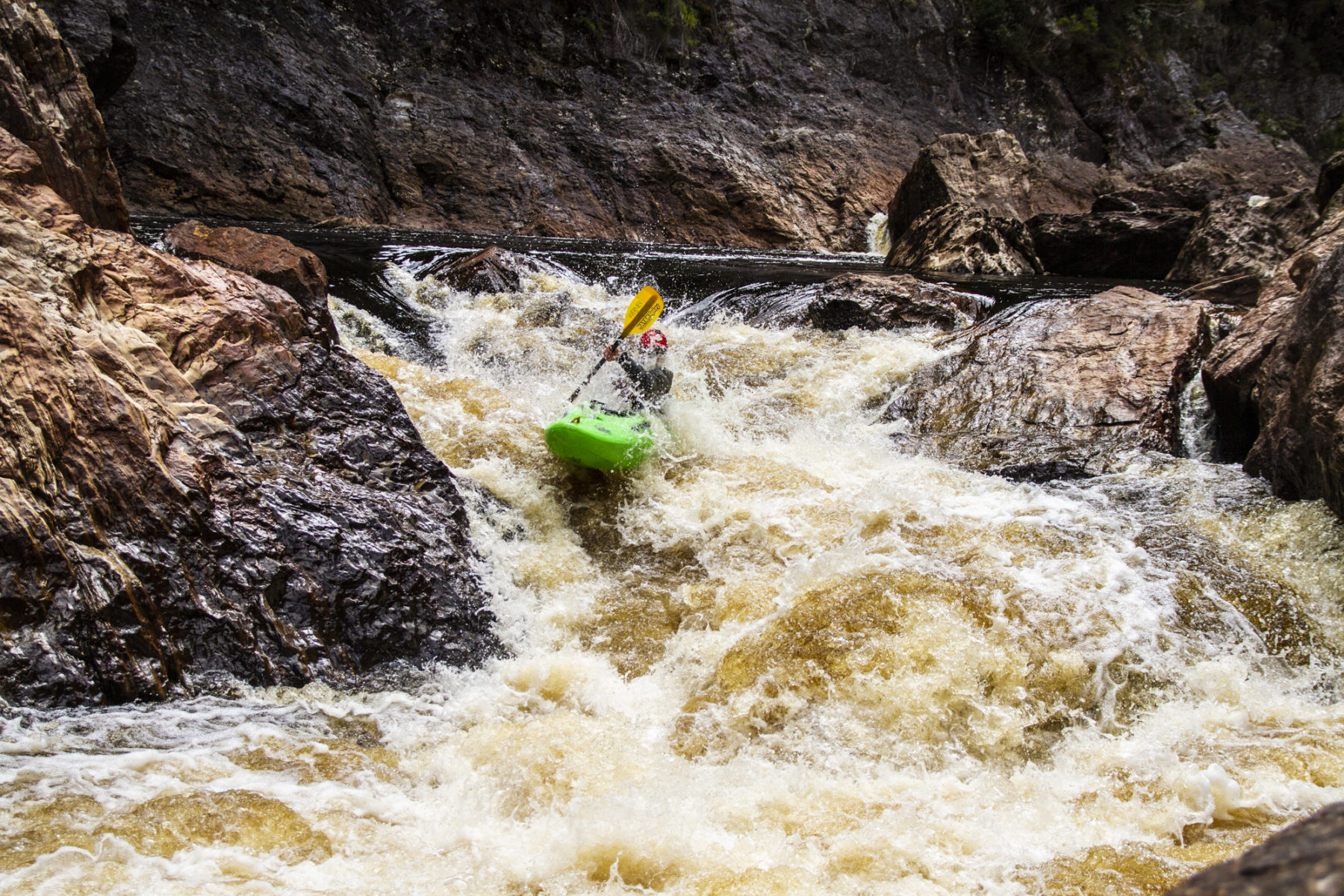
Soon after, we stopped to see a small riverside waterfall and then stopped, rather more abruptly, at the head of The Churn, a Class 6 monster series of rapids. Here the guides used ropes to lower the rafts down. We rejoined them to run the Class 4 Coruscades – which were brilliant fun – and then watched Oscar tackle the whitewater in the kayak. The camp site at Coruscades was a welcome sight. From here, the Great Ravine beckoned.
An increasingly narrow world
Portages are one of the less fun aspects of river-running, as I was reminded when our day ay started with the toughest portage so far – from our camp site over a slippery, steep and narrow track to the bottom of the Coruscades rapid. We dragged, carried and swore at the eskies and other heavy pieces of equipment. It took a couple of hours to get it all done, then finally we were paddling. Well, for a short while, anyway.
It was a big day for portaging, and we repeated the morning’s procedure several times as we negotiated Sidewinder and then Thunderrush, where Rob, Peter, Phil and I helped drag the two rafts over huge boulders and into a fast-boiling rapid, where we got to do the “Wild Thing”. It really was like a kid’s adventure dream come true. Dan and his raft were first to do the dance. A slipknot secured the raft to a sunken log, the crew jumped in and, while being buffeted by the power of the rapid, unhitched the knot and shot out at speed into the river’s main channel. It was brilliant. Our raft also had Victor and his kayak on board. The extra weight and imbalance dragged the raft’s rear left corner down, threatening to capsize us before Oscar could release the rope. I am sure the crew’s screams had nothing to do with Oscar completing the uncoupling at record speed.
Rafting through the Great Ravine was like travelling through mythical lands: the knife-edge ridges and steep cliff walls were shrouded in mist and that atmosphere, plus some of the trip’s largest rapids, etched it in my memory as the best day on the river.
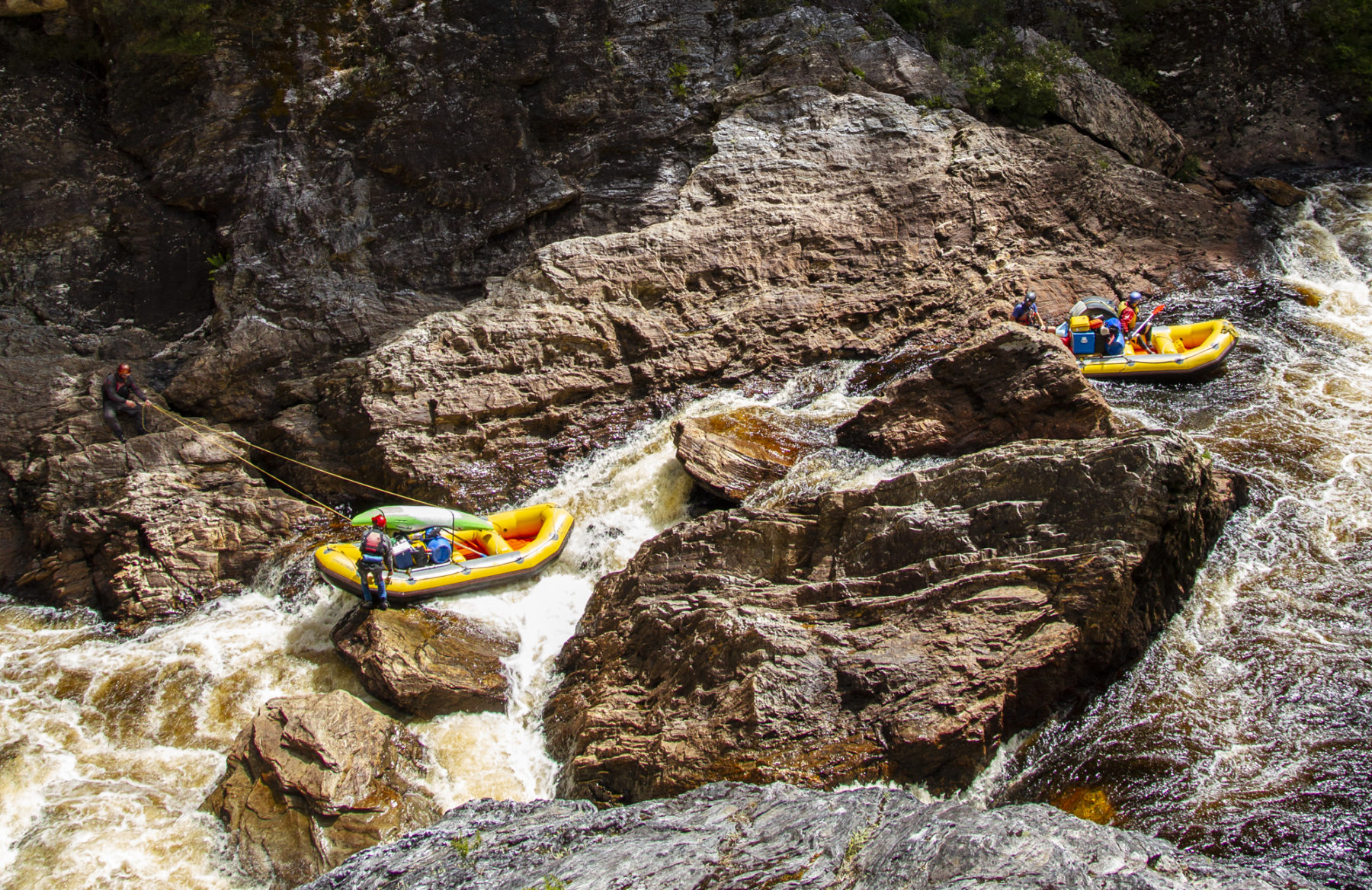
The Franklin was at its wildest at The Cauldron. The guides (with Rob assisting) had to portage this rapid, which is one of the river’s most dangerous. The last person to die on the Franklin drowned here after being trapped under the rocks. The two gear-laden rafts were inched through the pounding rapids, around huge boulders, then went into freefall over a rapid so tall it could be more accurately described as a waterfall. It was incredible to watch from the high bank on the opposite side of the river. The rafts – and the guides – were dwarfed by the immensity of the river; it was powerful stuff.
Later that day, on our way to Rafter’s Basin camp site, we passed through The Biscuit, the remnants of an ancient wall the river had broken through. The two ends, minus the middle section, really did look like a half-eaten bicky. Interestingly, The Biscuit was also earmarked as a potential location for a dam wall; the hydro dam plans included using the sidewalls to form the basis of the dam wall.
The reality of an iconic image
It was just a photograph. But it was a photograph that brought home to everyday Australians what was at risk. ‘Morning Mist, Rock Island Bend’, by Peter Dombrovskis, ran in The Age newspaper as a double-page colour spread (colour spreads in newspapers were exceedingly rare in the early ’80s). It appeared during the campaign to save the Franklin and has since been cited as one of its most influential moments. In the photo, Rock Island is shrouded in mist, with the Franklin’s waters swirling smoothly by. It’s a beautiful image that captures the essence of the river. This made it a powerful tool for the anti-dam campaigners, who were desperate to ensure every Australian realised what the Franklin River represented – something rare, wild and free.
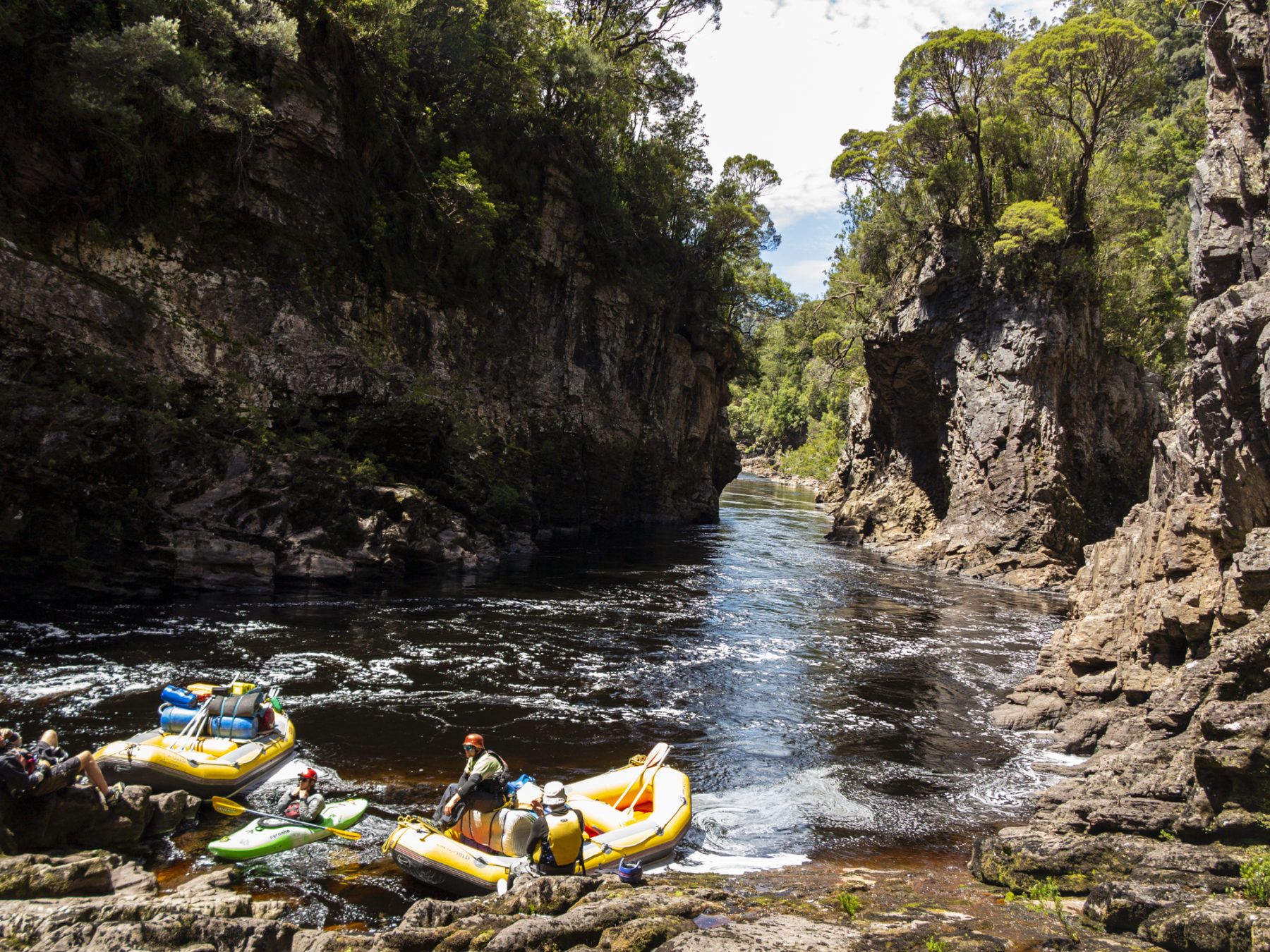
We reached Rock Island Bend on our second day in the Great Ravine. Bright sunshine gave us a totally different view of this location. It was still spectacular, but possessed a harder, wilder edge than the softly lit Dombrovskis image. We loitered here for a while, ambling up to explore a nearby waterfall, then jumped back in the rafts and passed The Pig Trough before arriving at the Franklin’s longest runnable rapids – Newland Cascades – and our camp site of the same name.
The rapids were an epic event, only outdone by the camp site and a brilliant lunch of sushi (suddenly, those heavy eskies didn’t seem quite so bad). We had our own choice of camp sites spread over a huge rock platform, sheltered by a massive overhang. My chosen digs (a perfectly sized slab of rock) provided me with a 180-degree view of the river below. Each night’s camp had been different to the last – but all were equally memorable. However, snuggling down in my sleeping bag, listening to the roar of the Cascades from my lofty, open-air perch was my ultimate “night out”.
Slowly, slowly on the Franklin River
Rafts are designed to go over rapids, but when it comes to long distances, of flat water, it’s a different story. And, on our last two days, that’s exactly what we found.
As we moved out of the Great Ravine, the tall cliffs on either side shrank, the river widened and maintaining forward momentum became a lot harder. Some sections of river were dead flat and we also copped the odd headwind, so our progress was slow. We explored Aboriginal caves along the way and, on our last night in the wild, camped at yet another beautiful location: a sandy beachhead on a bend in the river.
Our last day was even slower, as we portaged the gnarly Big Falls before continuing downriver to the opening of a slot canyon, which our guides dubbed “The Lost World”. Once again, the moniker was apt. Scrambling through the canyon’s entrance led us to an emerald-green wonder world, with everything covered in lustrous moss. We explored up the canyon for quite a way, splashing through deeper water and sidling along narrow, smooth-walled niches, before coming out higher up on drier land. It was spectacular, a brilliant sign-off.
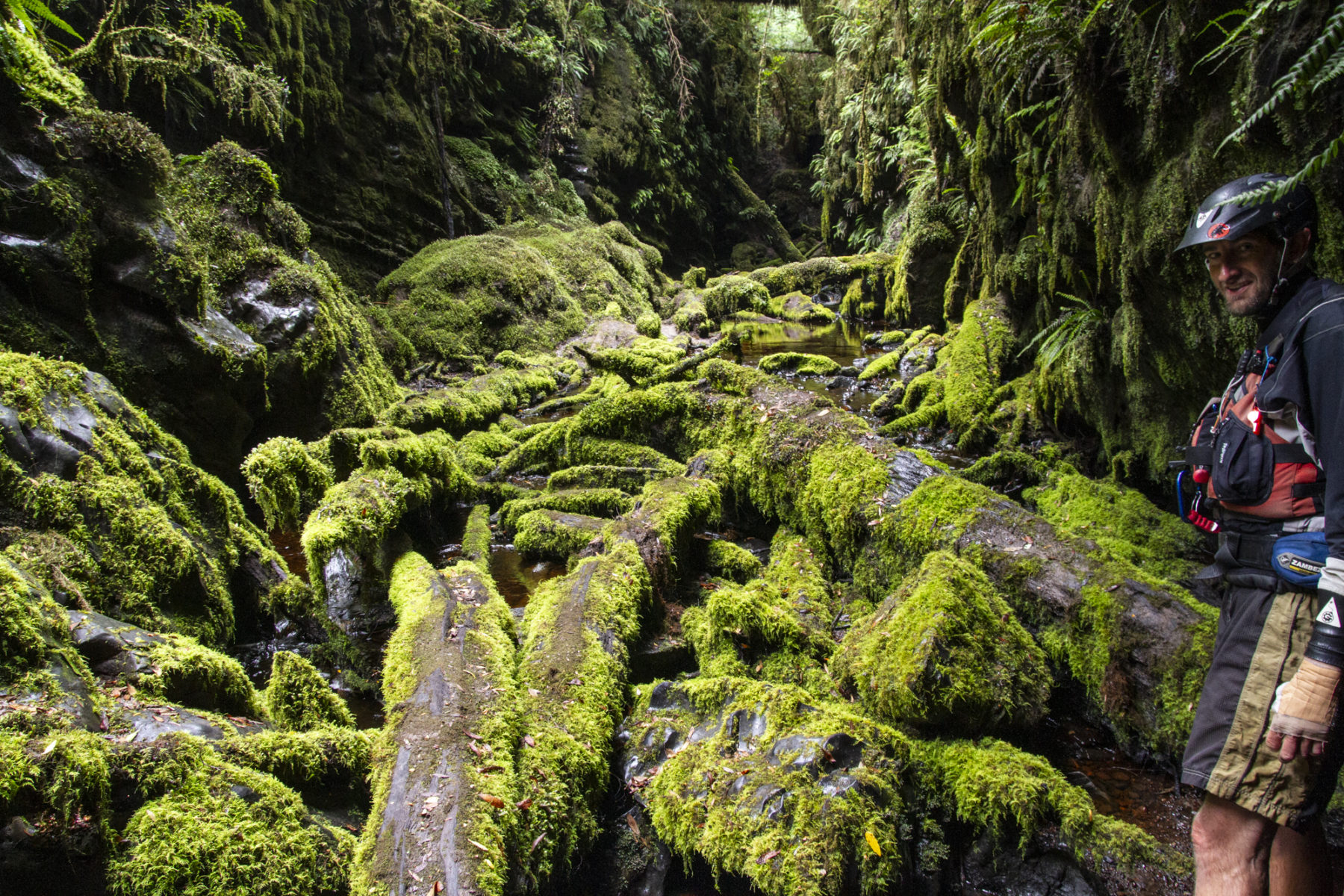
From The Lost World, we soon reached the confluence of the Franklin and Gordon rivers. The Gordon was running fast, so we rafted-up the two rafts, Oscar threw some Bob Marley on our raft’s cassette player and we flailed away into a headwind that wasn’t quite strong enough to match our paddle strokes and the rivers’ flow.
That last hour was, besides the perfectly suited tones of Bob, spent in near-silence. It seemed like everyone was trying to retain as much of the exhilarating experience we’d had over the 125km and eight days on the river as they could. The Jetty, our final camp, was empty when we arrived, but its steel-bound frame and national parks info board seemed like modern-day intrusions after our immersion in pure wilderness.
The Franklin River dream flows to an end
I waited a bloody long time to fulfil my dream of paddling the Franklin. For once, a dream was surpassed by the awesome reality, thanks to the river, the rapids, the landscape, the history and the all-encompassing sense of pure, unspoiled wilderness. It’s amazing to think this remains only thanks to a passionate, never-say-die group of people who believed the Franklin was worth fighting for.
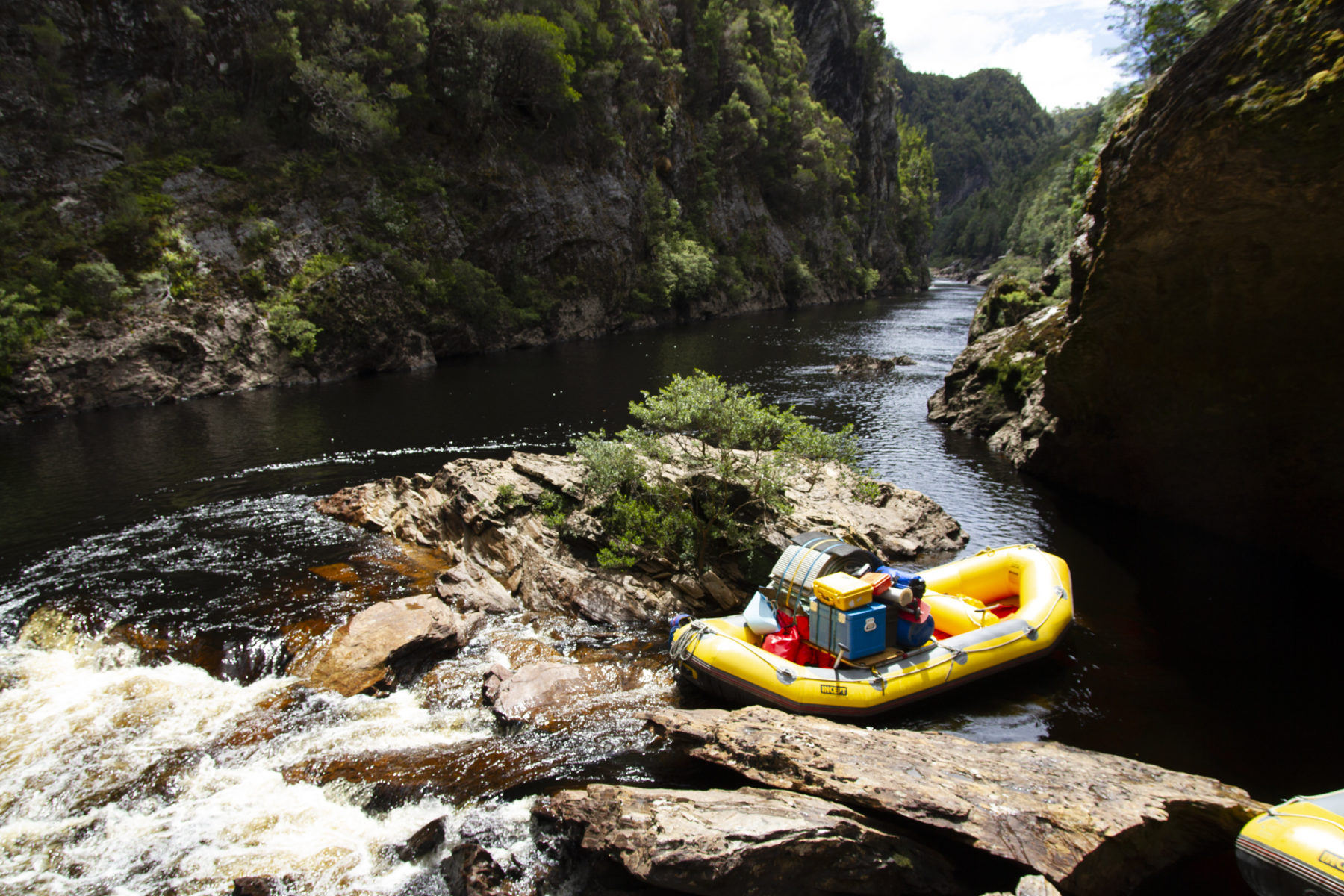
When Victor first mentioned that drinking from the river over the course of the trip would, in effect, transform you into the Franklin, I laughed – but his words also fostered a dreamy hope. At least, if some sense of the Franklin was retained inside me, it might tide me over until the next time I run the river. And there will be a next time…

